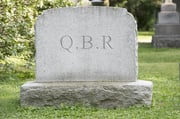How to Win the War Against Boring Quarterly Business Reviews
in Strategic Account Management, Quarterly Business Reviews, Key Account Management /The Quarterly Business Review: An Underutilized Opportunity for Customer Engagement
Quarterly business reviews are one of the most underutilized ways for key account managers to engage with their customers. A quarterly business review (QBR) is a meeting that takes place every 90 days between an account manager and a customer. The purpose of a QBR is to review performance results for the previous quarter and generate strategies to support the customer and improve results moving forward. The potential for success with QBRs is immense because all the key ingredients are present: you, your customer, and time dedicated specifically to generating strategies for improvement in the next quarter.
However, in spite of their great potential, QBRs have stagnated to the point of merely representing the status quo bias that many executives dread. Below is a summary of reasons why these reviews have become so ineffective, along with an arsenal of 12 secret weapons to help you win the war against boring, unproductive QBRs.
-
QBRs have evolved into snooze-fests.
The lecture-style format of many QBRs can put even the most energetic participants to sleep. The meetings are often dominated by one or two people who present data to the rest of the participants, who sit passively listening. This format fails to engage most participants and stifles the chance for active discussion that can produce winning ideas for the future.
Secret Weapon: Rotate presenters and use a multimedia format that includes videos, images, and interactive exercises to keep participants engaged.
-
Too many QBRs lack structure or purpose.
QBRs often frustrate customers because they lack organization or structure. Without a well-prepared agenda, there is often not enough attention given to key performance goals. Even worse is a QBR that completely deviates from the agenda it has, and becomes unpredictable in coverage of content.
Secret Weapon: Create an agenda and establish time guidelines for each item to ensure proper flow and coverage of key items.
-
QBRs waste time that could be devoted to optimizing performance.
QBRs often last 4-8 hours and can sometimes consume two full days. When you add travel time into the equation and consider the fact that account managers may spend 15–20 hours preparing for each QBR, the amount of time invested is astounding. With reviews occurring four times each year, you can plan to lose about 12 business days per year or roughly 5% of your time on QBRs. Imagine what you could achieve if you were able to dedicate those 12 days to achieving your goals and improving your customer service!
Secret Weapon: Limit QBRs to two hours if possible. One way to do this is to suggest that each speaker spend no more than nine minutes presenting material.
-
There is too much talking and not enough listening to the customer.
All too frequently, QBRs become a forum for verbal self-promotion. Additionally, the presentation format that characterizes most QBRs is neither productive nor conducive to helping the customer. It is virtually impossible to gain a better understanding of your customer’s needs if you are talking 90 percent of the time.
Secret Weapon: Remember to ask your customers questions during QBRs. Listen carefully to their responses and take notes.
-
QBRs are expensive.
As if lack of interest and excessive time expenditure aren’t painful enough, QBRs can also hurt your budget. Travel expenses, hotel costs, refreshments, and the cost of an off-site meeting place can all add up—especially if you have a long list of people attending the reviews. Other costs to consider include presentation materials and printing costs.
Secret Weapon: Consider the possibility of making one or two of your QBRs a virtual meeting to cut down on time and expense.
-
Written QBR content is often not clear or concise.
Results for the previous quarter should not be covered in a dissertation, but rather in a succinct summary. When a presenter uses five slides and spends 30 minutes covering results that could have been summarized in one simple graphic or snapshot, listener attention begins to dwindle.
Secret Weapon: Use simple graphs, figures, and bullet points to emphasize key points. Avoid using lengthy paragraphs and run-on sentences.
-
Lack of consistency leads to apathy.
Sporadic attendance or failure to cover key topics in your agendas can result in unproductive and disjointed QBRs. This lack of consistency can hinder preparation efforts among participants because they have no idea who will show up or what topic will end up overtaking the meeting.
Secret Weapon: Schedule QBRs one year in advance. Distribute agendas and clarify expectations ahead of time.
-
There is too much emphasis on past results and too little discussion of the future.
While the performance of the past 90 days certainly merits discussion, there are too many cases in which discussion of past results completely consumes the meeting. This leaves little time to discuss future direction or strategies for improvement.
Secret Weapon: Plan to spend at least 50% of your meeting discussing the future. Make sure the agenda is structured accordingly.
-
There are no consequences for failing to achieve goals.
Goal attainment is often a topic of discussion in QBRs. While goal attainment is typically celebrated, there are usually no penalties or consequences for failing to produce forecasted results. This lack of accountability adds to frustration for clients who are suffering their own set of consequences as a result of underperformance.
Secret Weapon: Stress your commitment to accountability by establishing consequences. This can be done jointly with customer input.
10) There is not enough focus given to customer feedback in QBRs.
A major drawback of QBRs is failure to sufficiently engage customers in discussions. Customers are often not asked for their input or asked about their specific questions, needs, or challenges. Quality improvement cannot be attained without sufficient customer engagement.
Secret Weapon: When preparing your agenda and suggested time guidelines, devote sufficient agenda time to customer questions and needs.
-
The tone of QBRs can often turn negative.
QBRs should be characterized by a supportive tone. Unfortunately, QBRs can quickly become a breeding ground for venting and complaining. This is particularly the case if the quarterly results being reviewed are less than stellar. A negative tone can make a QBR especially unpleasant when negativity is combined with a lack of structure.
Secret Weapon: Before the meeting, remind participants that the QBR is not the appropriate forum for venting anger or frustration, as this can derail productivity. Instead, focus attention on what can be done to improve future results.
-
QBRs may come to a close without any focus on action items.
When a QBR lacks structure, conciseness, or plans for future direction, it can end without your having established or addressed important action items. This defeats the purpose of the QBR and leaves customers scratching their heads, wondering what steps must be taken to meet your mutual goals and their own needs.
Secret Weapon: Make sure to include sufficient time in your agenda for action items. After the QBR, distribute a summary of key action items and which parties are responsible for each one.
Winning the Battle and the War Against Unproductive QBRs
Keep the above pitfalls and proposed secret weapons in mind as you structure your next QBR. These measures will help you to avoid the status quo bias that makes so many QBRs dull and ineffective.
The most important thing to remember as you battle boring, unproductive QBRs is that you are trying to win a larger war. This means that you do not stop fighting after your first-quarter QBR is successfully behind you. Your commitment to creating engaging, organized, customer-oriented QBRs time after time should become a part of your long-term mindset and management culture. This will enable you to win the battle and the war against unproductive QBRs!
Ready to learn more and take your QBRs to the next level? Download our QBR ebook for more practical tips!







